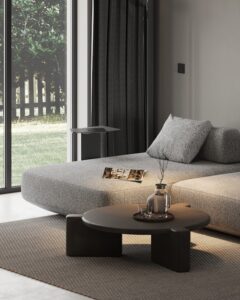Are Sofas Making Your Back Worse? Here’s How to Choose the Best Sofa for Back Pain Relief in 2025.
Let’s be honest—these days, it feels like we’re all aging faster than we should, and our bodies are showing signs. Every third conversation seems to include someone mentioning a bad back. Sound familiar? You’re not alone—and the good news is, your sofa might be part of the solution.
Choosing the right sofa can make a huge difference in your everyday comfort and long-term spinal health. The right support doesn’t just help you relax—it helps preserve your back for the future.
We’re just like you. That’s why we’ve done the research, tested countless sofas, and read hundreds of real customer reviews. We’ve also spoken with health and ergonomics experts to bring you this comprehensive guide.
In this post, we’ll break down the golden rules for choosing a sofa that supports a healthy back. From posture-friendly cushions to lumbar support, we’ll give you our top tips in 2025. Let’s dive in and help your back feel better—starting with where you sit every day. This post may contain affiliate links, which means I may earn a small commission if you click and make a purchase—at no extra cost to you. I only recommend products I truly believe in and think will add value to your life.
Table of Contents
What Causes Back Pain From Sofas?
If you’re dealing with back pain after lounging on the sofa, you’re not alone. While soft, deep couches may feel comfortable at first, they often lead to poor posture. When your spine isn’t properly supported, it curves unnaturally—putting pressure on your discs and straining muscles.
Many of us also pick up bad habits while sitting on the sofa, like crossing our legs or tucking our feet under us. These positions may feel cozy but throw off your spinal alignment over time.
Another common issue is sagging cushions. As sofas age, they lose structure, creating an uneven and unsupported surface. This misalignment can lead to lower back pain, stiffness, and discomfort.
Finally, spending long hours on the sofa without movement makes things worse. Prolonged sitting weakens your posture and increases the risk of chronic pain.
Top Features to Look for in a Sofa for back pain relief
Shopping for a new sofa? If you deal with back pain or simply want to support your spine long-term, choosing the right sofa makes all the difference. Here are the key features to look for in a sofa that supports your back—and your lifestyle.
1.Firm seat cushions
One of the most important features for back support is firmness. Sofas with firm cushions help maintain proper posture by preventing you from sinking too deeply, which can strain the lower back over time. Look for cushions that feel supportive—not stiff, but definitely not too soft. This can help you out.
2. Built-In Lumbar Support
Your spine naturally curves, and your sofa should help support that. Sofas with built-in lumbar support keep your posture aligned and reduce slouching, which is a common cause of chronic back pain. It’s a small detail with a big impact.
3. Adjustable Features
If you’re living with back issues, adjustability can be a game-changer. Reclining options or adjustable headrests let you personalize your seating position, taking pressure off key areas of your back. This is especially useful if multiple people will be using the sofa.
4. Seat Height & Depth That Fits Your Body
The best sofa for your back is one that fits your body. Make sure the seat height allows your feet to rest flat on the floor, with knees at a 90-degree angle. The seat depth should support your thighs without cutting off circulation. This may take a few test-sits in stores—but it’s worth it.
5. Supportive Backrest
Don’t overlook the backrest. A high, firm, and supportive backrest helps keep your spine in alignment, especially during longer sitting sessions. For those of us with back pain, this is an essential feature.
6. High-Quality Materials
Support doesn’t just come from design—it comes from the materials, too. Look for high-density foam and a sturdy frame, such as hardwood or steel. These materials help the sofa maintain its shape over time, which means continued support for your back in the long run.
7. Ergonomic Design
Want next-level comfort? Look for a sofa with ergonomic design. These models are built to match your body’s natural curves and encourage healthy posture. It might cost a little more, but your spine will thank you.
Final Tip: Always try before you buy. Everyone’s body is different, and what works for someone else may not work for you. Spend time sitting (or lounging) on different options and pay attention to how your back feels. Read more great tips about ergonomic sofas here.
How I Learned to Sit Without Wrecking My Back
For years, I didn’t think twice about how I sat—until the back pain started creeping in. Now I’m much more intentional about supporting my spine throughout the day. Here’s the tips that experts gave me that helped me the most:
- Back support matters – I always make sure my lower back has a slight arch by sitting all the way back in my chair. A small cushion works wonders.
- Feet on the floor – No more dangling legs or awkward perching. Keeping my feet flat (or on a footrest) with knees at a 90-degree angle has made a big difference.
- Neck in check – I used to crane my head forward without realizing it. Now, I gently tuck my chin and keep my head aligned with my shoulders. It helps reduce that tight-neck feeling by the end of the day.
If you’re dealing with back or neck pain from sitting all day, making these small changes might surprise you with how big the relief can be. Check out this video on how to improve your posture.
Daily Desk Habits That Keep My Body (and Mind) Happy
Let’s be real—sitting all day is rough on the body. But once I started adjusting my posture and taking regular breaks, my energy and focus improved too. Here’s what I stick to:
- Relaxed shoulders, comfy arms – I keep my shoulders down and my elbows close to my sides, resting comfortably at about a 90-degree angle. It keeps tension at bay.
- Move often – I now set reminders to stand, stretch, or walk around every 20–30 minutes. A short break does wonders to reset both body and brain.
- Avoid the no-no’s – I ditched the habit of crossing my legs or slouching sideways. It’s a simple tweak, but my circulation and posture have thanked me.
If you work at a desk like I do, these small shifts can be game-changers for your posture and overall well-being. Here’s a video for you desknerds.
Final thoughts
If you’re like me, your sofa is where you unwind after a long day—but it shouldn’t be where your back pain begins. I’ve learned the hard way that not all sofas are created equal when it comes to support and long-term comfort.
Choosing the best sofa for back pain relief isn’t just about style—it’s about protecting your spine, improving your posture, and feeling better every single day. From firm seat cushions and lumbar support to proper seat height and ergonomic design, small choices make a huge difference.
Pair the right sofa with healthy sitting habits and regular movement, and you’ve got a real shot at saying goodbye to that stubborn back pain. Trust me—your body will thank you.
If you’re serious about finding the most supportive sofa for back pain, stick to these expert-backed tips and don’t forget to test what works best for your body. Because comfort isn’t one-size-fits-all—and your spine deserves better.




Pingback: Back Pain in 2025? Your Sofa guaranteed is one of the reasons